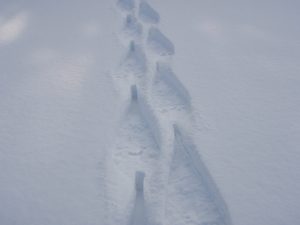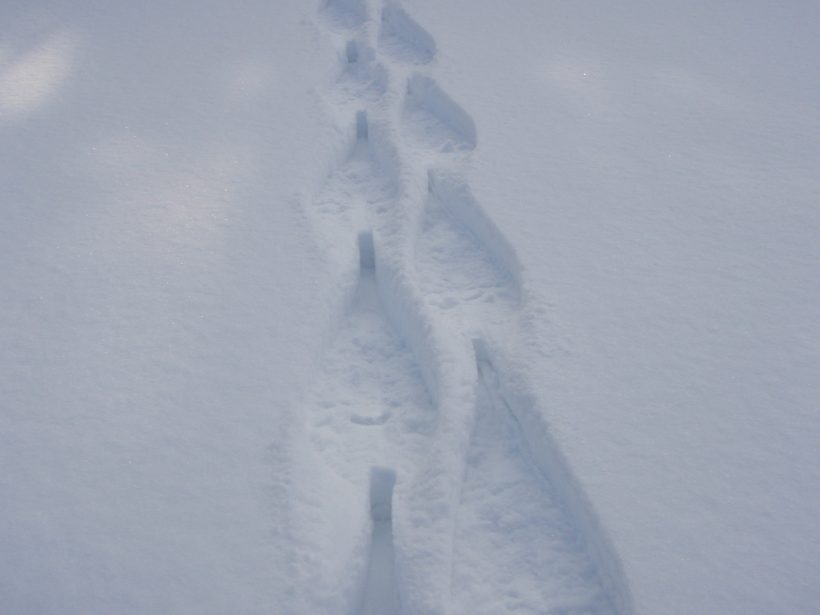
1975 Snowshoes
I read an article wherein the writer stated that the art of making snowshoes had been brought to North America when the first men crossed over into the continent from Asia. Too, the writer mentioned that they also brought the knowledge of skiing, but this had been discarded in favour of snowshoes, as there was so much snow. Since artifacts and arrowheads have been found in the western part of Canada that date back twenty thousand years, those two methods of winter travel must have been around a long time. The man or men (perhaps women) who first devised something for the feet that would keep the traveller from wading in deep snow must have been quite an inventor at that time. It would have been interesting to see what the first pair looked like. I imagine the first Europeans who saw snowshoes were a bit perplexed, but when they tried to travel without them would soon realize how necessary they were.
When I was quite young noone ever heard of buying a pair of snowshoes at a store. Most of the men who worked in the woods a lot made their own, and as in every other case, there were some who were more adept at making snowshoes than others, and some men spent a lot of time during the winter making snowshoes for others. I do not remember much about the pattern then, but I believe the standard 14×48 would be close to what people were wearing then. The filling would be cow hide, at least in our area, for there were not many moose.
In the woods, Indians who make their own shoes, or did when I trapped in the north, used mostly moose hide for their filling. It is good, does not sag too much when wet, but after a couple of hard seasons wears out, and strings will just start to break. Was once told that caribou babiche makes the best filling as it really tightens when wet.
One of the first commercial snowshoe factories in this area was started at Fox Point, on Lake of Bays. Tom Salmon, who later became famous as a guide and woodsman, began making them for years – the well known Salmon shoe. He made them any shape desired, the filling was good, and they were the standard all other makes were judged by. Later more shoes came on the market, and there are still a great many makes of snowshoes offered to the public.
Salmon had worked out a different method of lacing the strings, quite a bit better than the more common method. After he retired, a group from the area made shoes for a while. There is still one place selling shoes with that type of filling, at Whitney.
White ash was the best for frames. Black ash was used a lot but it did not have the staying power of white ash. In the north they do not have white ash, and you see frames of black ash, yellow birch and even white birch. And so many shapes. In the far north, especially in Quebec, the natives use what is called “Bear Paw” shoes. These are almost round, but work well in very light snow. Too, I saw, and this in Ontario, shoes being used that were well over six feet long, and narrow. Then a lot of shoes now being made have a frame made of two pieces. The old method of just using one piece for a frame seems to be losing face. When this type of frame first appeared perhaps fifty years ago, most woodsmen would not use them, as the pointed toe often caught in the brush. But good wood is getting harder to get, so two piece frames may be around a long time. I mentioned yellow birch for frames. Nice to work with, but very slippery. It does not wear as well as black ash.
Then there is the proper harness for snowshoes. I have always been used to a leather harness. I even developed my own and would not care to use anything else. But there are many types of harness. Some woodsmen like lamp wick, as it is soft. But it wears and breaks so easily. The “Hudson Bay Hitch” allows one to twist the foot free if you should go through the ice. Most wear some type of leather harness.
The snowmobile meant that trappers and others that work in the bush would not wear out so many shoes, but it also meant that snowmobilers also wanted shoes. So the demand is high, and it is hard to buy a really good pair. There are still a number of clubs who think snowshoeing is fun but I doubt if any of them had to break trail all day with a pack on their back. Not so funny then.
